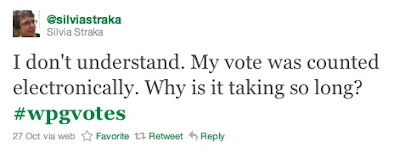Why? Because I didn’t watch it on TV.
My primary source as news developed was the #wpg votes Twitter feed with CBC Radio 1 streaming live online in the background.
Together, they gave me the up-to-the-minute (or, with Twitter, up-to-the-second) information I needed, while eliminating what I now consider the rather useless visual that TV provides.
I didn’t miss the line of candidates’ photos on screen with vote numbers flickering beside them, or the constant turn to a panel of experts giving their thoughts and predictions as the votes come in.
Instead, thanks to Twitter, I looked at the occasional backstage photos that journalists and CreComm J Majors tweeted and enjoyed the mixed commentating and news updates from “regular” people, and media professionals with some nice interaction and RTing between the two.
Sometimes I think that presenting local events in the traditional newscast format can create a disconnect, in that it doesn’t give that close-to-home, unscripted feel of news as it happens.
Following the election via the very untraditional Twitter, however, made the entire thing seem more relevant by being able to read real reactions from “regular” people (admittingly not always a good thing), while at the same time just as informative because of input from media outlets, too.
That being said, new media isn’t for everyone, and this time around the local TV stations really failed to deliver for those looking to them for immediate results.
I should point out that I don’t live in Winnipeg, and therefore couldn’t vote in that election (even though its results still very much affect me), but way out in my small part of the world, new media also tried to be a voice in the election fray.
Tried, and... well, it was a very quiet voice. Of the nine people running, only two had an online presence.
One candidate effectively (in my case) used this presence to appeal to youth voters, sending them a targeted letter with links to his blog and Facebook page.
He was the only person running to acknowledge the youth vote, as well as understand that it required an approach different from the usual canvassing. Case in point, although my parents read the brochures, letters, and other scraps of paper handed to them at the door, I preferred to read up whatever I could about candidates online.
I imagine there was a time when people didn’t know who was their new mayor until they read the (print!) newspaper the next day. Now, with better technology and web posting, people can – and demand – to know the results immediately.
Unless, of course, you have to rely on the Association of Manitoba Municipalities (AMM) for your results. Even with their website advertised as the new “one-stop shop on election night”, I still had a day’s wait. As Kenton Larsen would say, 'wah wah'!
New media works, but only if you use it well. AMM election organizers take note.




